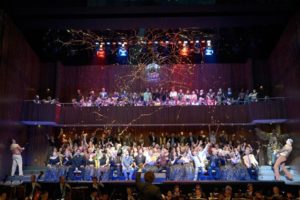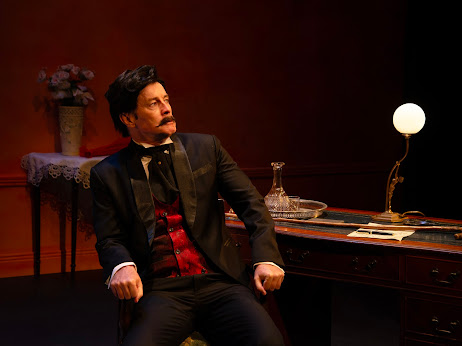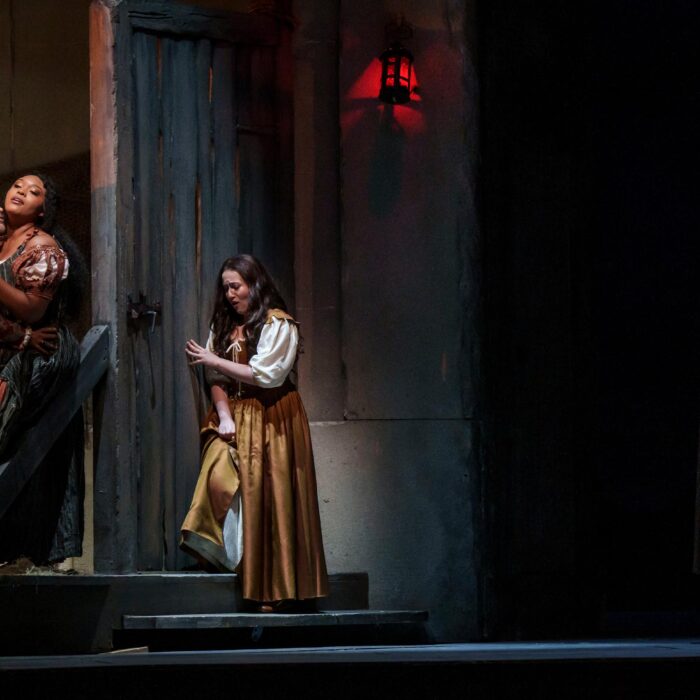
Deutsche Oper Berlin 2017-18 Review – Rigoletto: Zeljko Lucic To The Rescue In Muddled Jan Bosse Production
By Santosh VenkataramanThe Deutsche Oper Berlin had a problem for its final presentation of “Rigoletto” on Thursday night. The baritone Markus Bruck was forced to cancel around noon that day from his scheduled appearance in the title role.
Fortunately, the company had a tremendous solution at hand. The Serbian baritone Zeljko Lucic was available since he was present to perform in “Nabucco” later over the weekend. And it was Lucic who saved the day and breathed life into this production of “Rigoletto.”
Theater Within a Theater
This production by Jan Bosse originated in 2013 in Berlin. The first scene mirrors what the auditorium at the Deutsche Oper looks like, with five rows of yellow seats filled with patrons ready for a show. The wood paneling on the side and even the ushers that let in “audience members” look realistic to the point that it resembled the first few rows of the house.
It is hard to determine what this is supposed to convey, with Rigoletto appearing first in a gold rabbit costume with his head entirely covered. He was less a court jester and more a cartoon figure. There is much merriment and even streamers that pop into the actual crowd set off by the Duke of Mantua. The Duke quickly sets his sights on the Countess Ceprano, sitting in the audience along with her husband.
The Duke enters the action from the actual crowd (not to be confused with the fictitious one on stage). There is much singing from him and others in front of the orchestra and elsewhere; again, it’s not certain what effect is truly desired.
If the gimmick seemed overwrought in the first scene, those same yellow seats are present throughout. For the location of Rigoletto’s home in the second part of Act one, the top three rows are raised and the house is within the scaffolding underneath.
This is how Gilda is introduced to the story, sitting inside her home on the beams. By this point, Rigoletto has thankfully shed his “rabbit head,” with Lucic’s head appearing uncovered. If the choice is his to omit a jester’s head covering that other artists employ, it’s a wise one given how ridiculous the costume looks.
Lucic commands the proceedings through the first act. His mulling over the consequences of Ceprano’s curse displays his vulnerability as does his return home to meet the daughter whom he treasures. His Rigoletto is a troubled individual who has received the short end of the stick in life.
Distracting Set
While Lucic is able to overcome the staging, it doesn’t help the soprano Hila Fahima as Gilda. Her presence within the metal bars seem to interpret her as a woman within a figurative prison at home. The problem is that it also serves to make Gilda into more of an isolated role alongside Lucic’s high-wattage display.
The fresh-faced Fahima sang brightly and with an innocence that gave her vibrant, teenage qualities. Her “Caro nome” was earnest and tender. The connection between her Gilda and Lucic’s Rigoletto seemed a bit contrived since they stood several feet apart in Bosse’s stage contraption.
What was also confusing was how the Duke of Mantua entered their domain since it was difficult to decipher what a door or entrance could possibly have been. Tenor Pavel Valuzhin as the Duke appeared into the chamber in a flash. Even odder was the abduction scene which happened so quickly it wasn’t even clear if Rigoletto was blindfolded; for an opera as familiar as this one, it sure was trying to keep up with the plot on many occasions.
Back of the Stage
More bewilderment accompanied Act three, with Sparafucile’s home simply being the back of the five rows of seats. Valuzhin is forced to sing his “La Donna e mobile” while sitting on the back row, with his back to the audience at times. The appearance of Maddalena comes as somewhat of a surprise.
Valuzhin’s costumes captured the gist of this production. Alternately clad in leather pants and an eccentric short or an all-pink ensemble, he looked part seducer and car salesman from the 1970s.
If “La Donna e mobile” put Valuzhin in an unusual position, it was even more the case for his “Questa o quella” that began with him in the audience and had him moving all over.
The Tonic
Fortunately, Lucic was the focal point of this Rigoletto. It is a role he has sung in many places, and one he pulls off convincingly even though his instrument is considered deeper than that of a classic Verdi baritone. His Rigoletto is one that creates a great sense of empathy to all witnessing it.
This was seen best in his Act two, “Cortigiani,” in which the jester asks for the return of his daughter. The abductors are clad in black and stand behind the rows of seats as they make fun of the old man. Lucic’s mournful plea forces them to turn their backs to him once they realize the true effect of their prank and the pain that he is suffering. It highlights how exposed Rigoletto truly is.
Mezzo-soprano Judit Kutasi portrays both Giovanna and Maddalena; both are treated as afterthoughts in this production. Bass Tobias Kehrer presents a menacing Sparafucile, although the scene with his sister felt muddled. Maestro Guillermo García Calvo had much on stage to contend with and against in guiding the Deutsche Oper orchestra through this Verdi masterpiece.
“Rigoletto” is a great vehicle for bringing out the emotions of the three distinct characters of Rigoletto, Gilda and the Duke. The Bosse production is altogether too distracting to drive any audience member to tears, given its circus-like setting. Credit Lucic for cutting through it to perform his role to the fullest.


